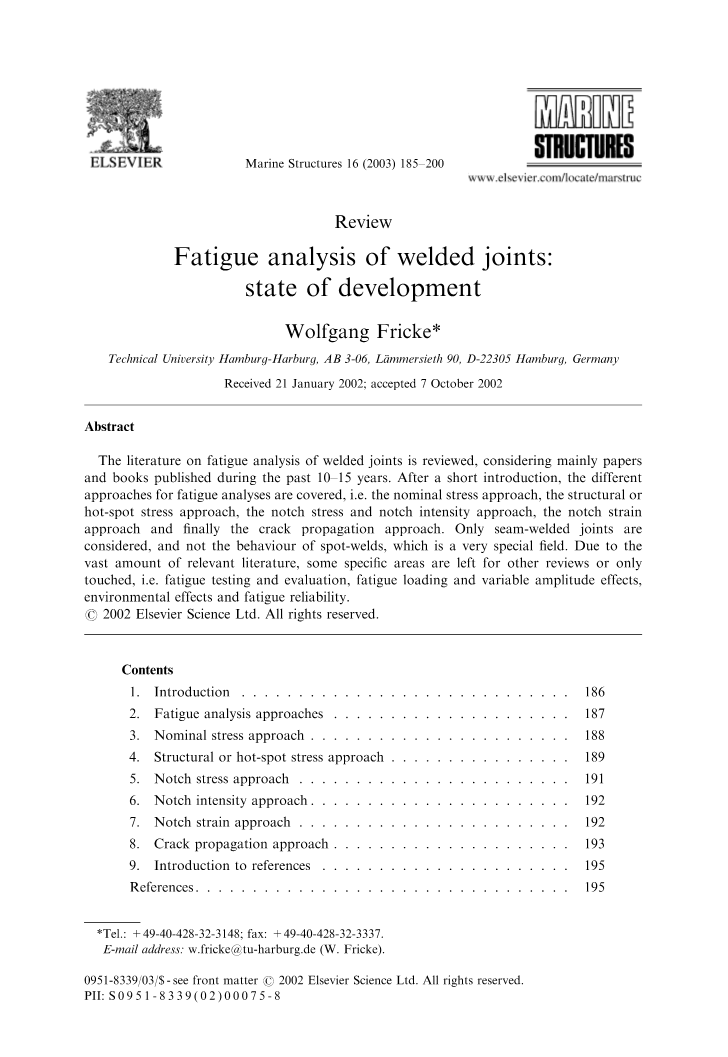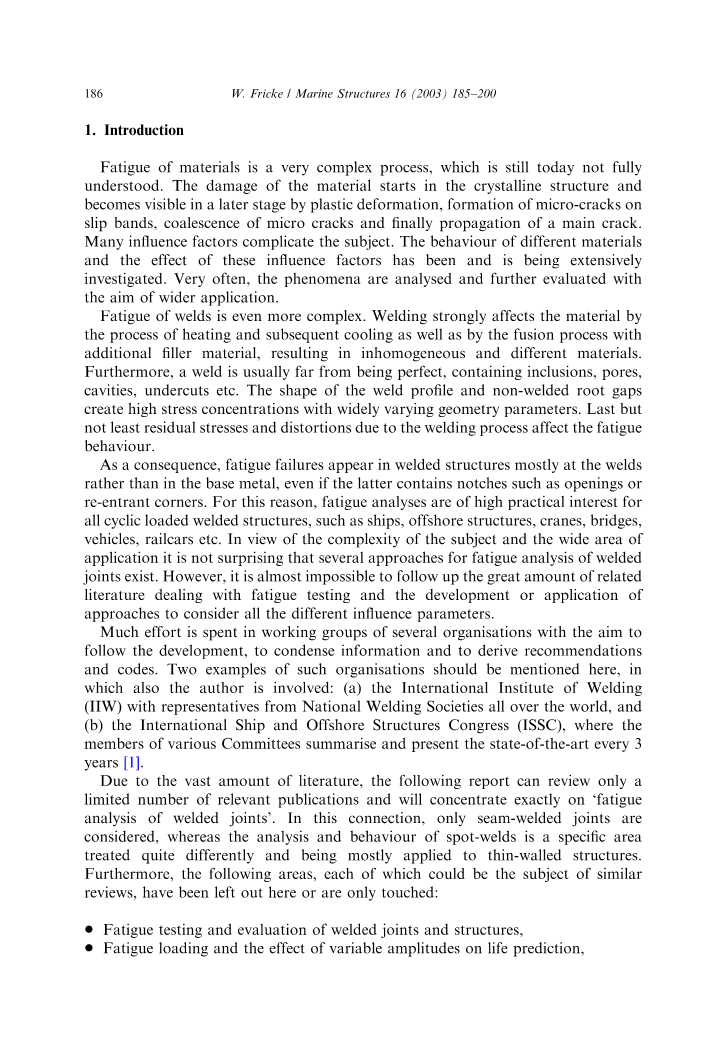原文
作者:Wolfgang Fricke
出处:Marine Structures 16 (2003) 185–200
Fatigue analysis of welded joints:
state of development
Abstract
The literature on fatigue analysis of welded joints is reviewed, considering mainly papers and books published during the past 10–15 years. After a short introduction, the different approaches for fatigue analyses are covered, i.e. the nominal stress approach,the structural or hot-spot stress approach, the notch stress and notch intensity approach, the notch strain approach and finally the crack propagation approach. Only seam-welded joints are considered, and not the behaviour of spot-welds, which is a very special field. Due to the vast amount of relevant literature, some specific areas are left for other reviews or only touched, i.e. fatigue testing and evaluation, fatigue loading and variable amplitude effects, environmental effects and fatigue reliability.
Contents
- Introduction . . . . . . . . . . . . . . . . . . . . . . . . . . 186
- Fatigue analysis approaches . . . . . . . . . . . . . . . . . . . . 187
- Nominal stress approach . . . . . . . . . . . . . . . . . . . . . 188
- Structural or hot-spot stress approach . . . . . . . . . . . . . . . . 189
- Notch stress approach . . . . . . . . . . . . . . . . . . . . . . 191 6. Notch intensity approach . . . . . . . . . . . . . . . . . . . . . 192
- Notch strain approach . . . . . . . . . . . . . . . . . . . . . . 192 8. Crack propagation approach . . . . . . . . . . . . . . . . . . . 193
- Introduction to references . . . . . . . . . . . . . . . . . . . . 195 References . . . . . . . . . . . . . . . . . . . . . . . . . . . . . . . 195
- Introduction
Fatigue of materials is a very complex process, which is still today not fully understood. The damage of the material starts in the crystalline structure and becomes visible in a later stage by plastic deformation, formation of micro-cracks on slip bands, coalescence of micro cracks and finally propagation of a main crack. Many influence factors complicate the subject. The behaviour of different materials and the effect of these influence factors has been and is being extensively investigated. Very often, the phenomena are analysed and further evaluated with the aim of wider application.
Fatigue of welds is even more complex. Welding strongly affects the material by the process of heating and subsequent cooling as well as by the fusion process with additional filler material, resulting in inhomogeneous and different materials. Furthermore, a weld is usually far from being perfect, containing inclusions, pores, cavities, undercuts etc. The shape of the weld profile and non-welded root gaps create high stress concentrations with widely varying geometry parameters. Last but not least residual stresses and distortions due to the welding process affect the fatigue behaviour.
As a consequence, fatigue failures appear in welded structures mostly at the welds rather than in the base metal, even if the latter contains notches such as openings or re-entrant corners. For this reason, fatigue analyses are of high practical interest for all cyclic loaded welded structures, such as ships, offshore structures, cranes, bridges, vehicles, railcars etc. In view of the complexity of the subject and the wide area of application it is not surprising that several approaches for fatigue analysis of welded joints exist. However, it is almost impossible to follow up the great amount of related literature dealing with fatigue testing and the development or application of approaches to consider all the different influence parameters.
Much effort is spent in working groups of several organisations with the aim to follow the development, to condense information and to derive recommendations and codes. Two examples of such organisations should be mentioned here, in which also the author is involved: (a) the International Institute of Welding (IIW) with representatives from National Welding Societies all over the world, and (b) the International Ship and Offshore Structures Congress (ISSC), where the members of various Committees summarise and present the state-of-the-art every 3 years[1].
Due to the vast amount of literature, the following report can review only a limited number of relevant publications and will concentrate exactly on lsquo;fatigue analysis of welded jointsrsquo;. In this connection, only seam-welded joints are considered, whereas the analysis and behaviour of spot-welds is a specific area treated quite differently and being mostly applied to thin-walled structures. Furthermore, the following areas, each of which could be the subject of similar reviews, have been left out here or are only touched:
- Fatigue testing and evaluation of welded joints and structures,
- Fatigue loading and the effect of variable amplitudes on life prediction,
- Consideration of environmental effects (in particular corrosion),
- Application of reliability methods to the fatigue assessment (fatigue reliability).
On the other hand, much progress has been achieved during the past years in the development of approaches considering the local geometry and material effects, which will form the main part of the following review.
Before different areas of the fatigue assessment of welded joints are covered, some books are mentioned in the following, which give introduction into the subject and summarise the fundamentals as well as recent developments. Among others, Suresh[2] gives a comprehensive description of the mechanics and micro-mechanics of fatigue in metals. The topic of the textbook by Dowling[3] is the mechanical behaviour of materials in general, but emphasis is placed on pr
剩余内容已隐藏,支付完成后下载完整资料
英语原文共 16 页,剩余内容已隐藏,支付完成后下载完整资料
资料编号:[139394],资料为PDF文档或Word文档,PDF文档可免费转换为Word
课题毕业论文、外文翻译、任务书、文献综述、开题报告、程序设计、图纸设计等资料可联系客服协助查找。




